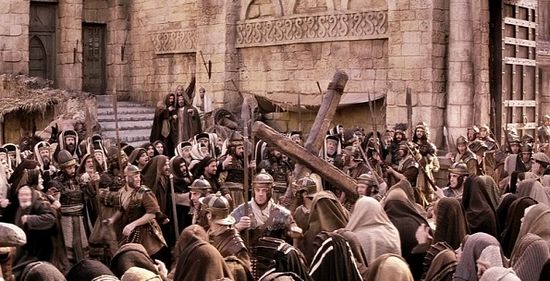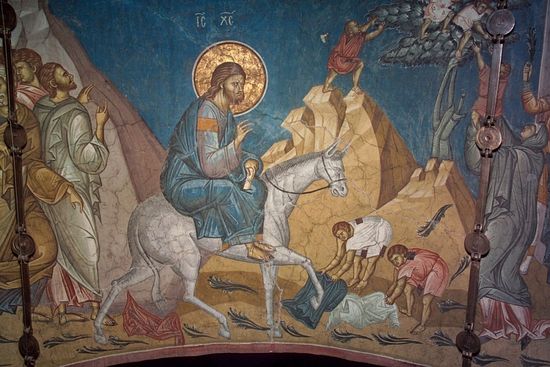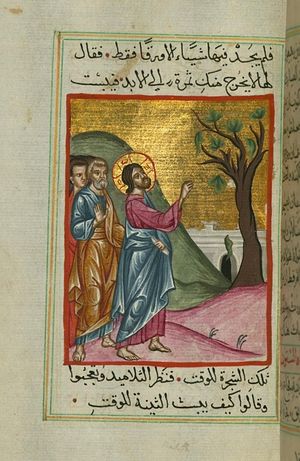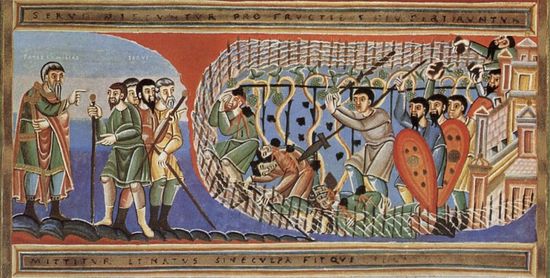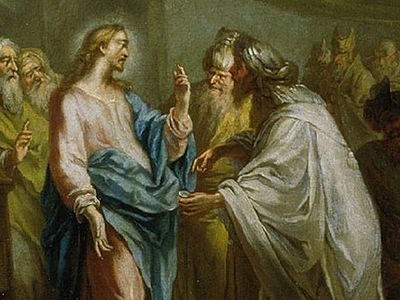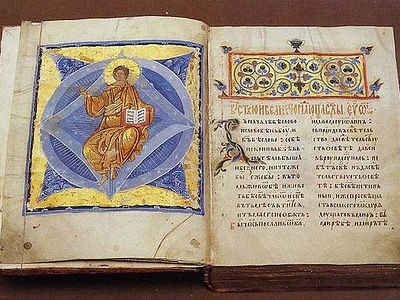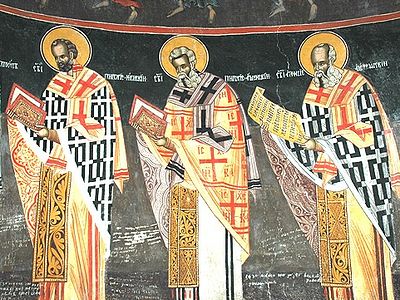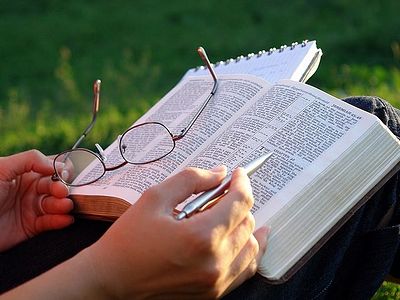Dr. Jeannie Constaninou continues her Ancient Faith Radio podcast series.
In this lesson we will get into the actual Biblical texts that we read during Holy Week about the conflicts between Christ and the Jewish leaders.
A listener wrote to tell me that there were many different kinds of Pharisees and that some did not object to such things as Christ healing on the Sabbath. That’s true, but the ones who did object were the ones who did not agree with Christ. So obviously, when I’m explaining these things to you I’m not going to tell you everything there is to know about a certain subject; there is so much to be said about any Gospel story, about any detail of life in first century Judaism, that there’s simply not enough time to give you all kinds of details about the different kinds of groups. When it comes up, and perhaps in the context of a serious study of the Gospels later, we may have a chance to get into more detail. But otherwise, I’m trying to just give you a general idea about these groups. Of course, there were different kinds of Pharisees—even St. Paul tells us that he belonged to a part of the Pharisees and he was among the strictest, so there was a varying level of adherence to the Law of Moses in terms of the strictness expected by different kinds of Pharisees. I simply can’t say everything and qualify all of my statements or we would be here all day.
Now in the last program I explained the characteristics of the first main groups in first century Judaism. The Pharisees emphasized observance of the Law of Moses, which Is not the Ten Commandments, but the countless regulations that govern daily Jewish life. The Pharisees included as the Law not only the actual rules found in the Scriptures, but a long and complex oral tradition of interpretation that had developed over the centuries. They added thousands of additional regulations that weren’t in the Bible. That’s called the Oral Law; and they felt that it was more important than the written law because it was their recent interpretation, while the written Law, the Law of Moses, was sort of outdated because it went back to the time of Moses. The Pharisees believed that the Law and the Prophets, both parts of Scripture, were Scripture. They believed in the resurrection of the dead, their leaders were rabbis, and their locus of operation was basically the synagogue. They believed that someone’s righteousness before God, that is, his acceptance by God, depended upon his observance of the outward requirements of the Law—especially ritual purity. That is what they emphasized the most—outward ritual purity; that is, not physical cleanliness, but ritual or legal cleanliness. They did not value one’s inner disposition as much as this. That’s not to say that no Pharisees ever discussed inner disposition, but obviously it was not emphasized, because they were so busy observing all of the laws of ritual cleanliness. The Pharisees were successful because they adapted the Law of Moses to changing times, and were very well respected by the Jews of their day, who saw the Pharisees following the Law. However, the Pharisees had added thousands of rules that made the Law very burdensome to follow for the ordinary Jew.
Scribes and Pharisees, and ritual purity.
The Scribes, we had said, were the highest level of legal expert available at the time, and this was why they are often called “lawyers” in the New Testament. They were even more knowledgably than the Pharisees. They emphasized the Law of Moses also, like the Pharisees. They were scrupulous about keeping all of the regulations of the Law, but likewise did not give much attention to the inner heart, the practice of virtue, etc. Now why did the Pharisees and the Scribes appose Christ? Because He did not care about ritual purity. He wanted spiritual purity. Now, this does not mean that Christ did not observe the Law. In some respects, He certainly did. He went to the synagogue on the Sabbath, participated in the Jewish festivals, etc. But he did not believe that outward ritual purity was more important than inner virtue, love of neighbor, mercy, justice, patience, forgiveness, etc. Now even if some Pharisees did not object to the Lord healing on the Sabbath—there may have been some that felt that was acceptable, to heal a person on the Sabbath—nonetheless, the Lord did many things that offended most, if not all of the Pharisees and the Scribes because of their emphasis on ritual purity. What did He do? He ate with tax collectors, prostitutes and sinners. Just entering the house of such a person would make you ritually defiled in the eyes of the Law. The Lord touched dead bodies, such as the only son of the widow of Nain (in the Gospel of Luke), or the daughter of Jairus, the little girl who was twelve years old. When he touched these people to raise them up, He had become ritually defiled. He didn’t run off to the Temple to offer sacrifice to remove the defilement. He didn’t consider Himself defiled. He didn’t engage in ceremonial, ritual washings or sacrifices to remove the ritual defilement. What else did He do? He allowed the woman who was a sinner to touch Him when she cried at His feet. This is a defiling thing. He allowed his disciples to pick grain on the Sabbath and clean it as they were walking through the field. This was considered work, but it was necessary because they were hungry.
So anyhow, the point is there are countless examples of how Christ as a rabbi violated the basic expectation that a rabbi would observe the Law of Moses and teach others to do the same. And so when He didn’t teach others to do the same, when He set a bad example—as far as the Pharisees were concerned—this made Him a false prophet, which deserves the death penalty. Of course one of the things He did that also really made them extremely upset is that He claimed the authority to forgive sins. He claimed authority over the Sabbath when He said He was the master of the Sabbath, and this was pretty bold on His part.
The Sadducees and the Temple.
Now what about the Sadducees? They differed from the Pharisees in that they emphasized ritual purity, especially through animal sacrifice, but not so much through the Law of Moses. They did not recognize the oral tradition of the Pharisees, those thousands of regulations, as binding on Jews. The Sadducees leaders were associated with the chief-priests and their locus of attention was the Temple. The Temple in Jerusalem was the only place in the whole world where animal sacrifice could be offered by the Jewish people, which was required by the Law of Moses, so it was extremely important.
The Sadducees came from the upper-classes and they formed part of the ruling elite. They were wealthy; they were politically and religiously conservative because they held the power of the nation. They had to work in cooperation with the Romans, and so of course they wanted to keep their place of power. So that’s why they were conservative. They did not believe in the resurrection and they only accepted the Torah as Scripture—the first five books of the Bible. The Pharisees accepted both the Torah, (“the Law”) and the Prophets as Scripture.
The chief-priests, like the Sadducees, were interested in preserving the Temple and encouraging animal sacrifice. So how did the Lord offend the Sadducees and the chief-priests? Well of course, the cleansing of the Temple was one way that He certainly offended them. And why did He cleanse the Temple? Because the Jews had not borne spiritual fruit through the Temple. It was a place of basically empty ritual sacrifice, while the emphasis of the Lord was on inner purity and virtue over ritual sacrifice. He said things such as, “Before you come to the Temple with your offering, go and be reconciled with your brother.” One of the worst things that the Lord did to offend the Sadducees and the chief-priests was that He predicted the destruction of the Temple, and we will see that this is the first charge which is brought against Him at his trial.
* * *
Now let’s begin our lesson. “Illumine our hearts, O Master Who loves mankind, with the pure light of Thy divine knowledge. Open the eyes of our mind to understand Thy gospel teachings. Implant in us also the fear of Thy blessed commandments, that trampling down all carnal desires, we may enter upon a spiritual manner of living, both thinking and doing such things as are well-pleasing to Thee. For Thou art the illumination of our souls and bodies, O Christ our God, and unto Thee we ascribe glory, together with Thy Father, Who is from everlasting, and Thine all-holy, good, and life-giving Spirit, now and ever and unto the ages of ages. Amen.”
The Gospel context of Holy Week
So today we’re going to examine the Gospel readings of early Holy Week. And I apologize in advance for this being a rather long podcast. I want to make sure that we discuss these early Gospel readings so that you are prepared for the Trials, and I want to make sure that we get through the Trials and Crucifixion before Pascha, so this is why this podcast may be a little bit long. I hope it doesn’t wear you out.
I’m basing my discussion, in terms of the Gospel readings, on the Greek tradition for the Services of Holy Week. I know that there are different liturgical traditions among the different Orthodox jurisdictions. I don’t know how Holy Week unfolds among all of the Orthodox, how similar we are in terms of precisely which services are performed. Even if your services aren’t exactly the same, nonetheless the message of the lesson today is very valid. The Church takes great care to place the events of Christ’s life in a context, not only theologically and spiritually, but historically. They want us to understand why things happened the way they did. I explained last time that the Saturday of Lazarus is placed by the Church at the beginning of Holy Week because it wants you to make the connection between the raising of Lazarus and Palm Sunday. The reason why the people came out to the streets of Jerusalem to welcome Christ and hail Him as the Messiah in the event that we remember on Palm Sunday is because of the raising of Lazarus. They had heard about this miraculous event. So we see Christ proclaimed and exalted, and it’s hard to understand why, all of a sudden, at the end of Holy Week, He is put to death. It wouldn’t make sense if we leapt from Palm Sunday to Great Thursday, so we don’t do that. Thus, the Church places these readings in perspective, a historical context, so that we are prepared and we understand what led to the Lord’s betrayal, His arrest, and Crucifixion.
I recently said that Catholics do not have a well-developed Holy Week. They call it “Passion Week,” not only Holy Week, and, very surprising to me, they call Palm Sunday “Passion Sunday.” They hold palms and have an entrance with palms at the beginning of the Mass, but the Gospel readings at the Mass that day is the Passion of Christ. They read about the Crucifixion on Palm Sunday. Isn’t that remarkable? Then almost nothing happens in their churches until Thursday, when they have the washing of the feet, the commemoration of the Last Supper, etc. But the Orthodox Church does not do this. It’s very careful to place events in sequence and context. So on Palm Sunday we celebrate with Christ and His disciples, because this was the only time in His earthly ministry in which He was acknowledged for what He truly was—the Messiah and the King of Israel. So Palm Sunday is a joyous day in the Orthodox Church. But that evening, on the evening of Palm Sunday, the mood darkens considerably as we begin to hear rather ominous Gospel readings about the growing tensions between Christ and the Jewish leaders.
The service—at least in the Greek tradition—of Palm Sunday evening, is actually the Matins of Holy Monday morning done “by anticipation.” As soon as the sun sets, liturgically it is considered to be the next day. This was the Jewish practice, and so we follow a very ancient practice. Thus, as soon as the evening arrives, we can have the service for the following day, and Palm Sunday evening is the first of what the Church calls “the Bridegroom services.” This refers to Christ calling Himself the Bridegroom.
The Parable of the Fig Tree.
Now one of the themes of Palm Sunday evening is the cursing and the withering of the fig tree. The cursing of the fig tree is one of those stories about Christ that makes people rather uncomfortable, because Jesus seems to be uncharacteristically and inexplicably vindictive against a poor, innocent tree. But the meaning of Christ’s actions, like the cleansing of the Temple, must be understood as a prophetic sign.
Mark, in his Gospel, emphasizes the relationship between the two by placing the fig tree incident on the way to the city. There the Lord cleanses the Temple, and then they see that the fig tree has withered upon their return. There is terminology (I want to share this a little bit with you), that when New Testament scholars look at a story like that, a story within a story, they call it a “sandwich”. So Mark “sandwiches” together the fig tree and the Temple cleansing. In Matthew, it’s much more dramatic. The Lord sees the fig tree, He curses it and it withers immediately. Now, if you’re going to ask which is more accurate, Matthew or Mark, you’re missing the point of the story. Chrysostom would never approve of such a question. He called such questions “trifles” (“ta mikra”—small things) or insignificant details. He said you should behold the miracle and admire and glorify Him who was the worker of the miracle. So whether or not it happened all at once as they were standing there or they noticed that it had withered when they returned, it does not matter.
The point is that the fig tree was withered—and why is that? Remember all of the references made by John the Baptist and Forerunner about bearing fruit? And Christ telling people that they have to bear fruit of repentance? The fig tree symbolizes the nation of Israel which has failed to bear fruit. And we see the same kind of image in Jeremiah, Hosea, and Isaiah. Israel is called a tree from which fruit was to be expected. This was a very common image in the Old Testament. Now why was the fig tree cursed by Christ? Chrysostom said that the disciples might have confidence, that’s why the Lord cursed the fig tree. He always conferred benefits and never punished anyone, but it was necessary that He give His disciples a demonstration, a proof of His power to take vengeance also and to teach the disciples and the Jews that He submitted to Crucifixion by His own will, so He shows his power on the tree.
In this manner Christ also acts—when He curses the fig tree—according to the Old Testament prophets, as I said. This was like a symbolic, prophetic act. It dramatized the message that the nation of Israel was without spiritual fruit, and it would be withered. It had not produced fruit, and judgment would be made upon it. Chrysostom says that the fruit to be expected was not the Law, but faith, and that the time of faith had arrived. This was because Christ was preaching to them, and they were expected to respond with faith. But when they didn’t, they showed themselves to be a fruitless fig tree.
The time for figs has not arrived, Matthew tells us, which makes the cursing even more peculiar. But Chrysostom says that the Evangelists added this—that Christ went to the tree even though the time for figs had not arrived—to show that He went to the fig tree for this special purpose, to teach His disciples not out of hunger; and the disciples of course marveled at the miracle. There is so much more that can be said about the fig tree in the patristic tradition and in many other ways, but we’re going to move on because I want to be sure that we arrive at the trials by the time that’s appropriate for us.
The controversies with the Jewish leaders.
Now let’s talk about the controversies with the Jewish leaders. In Matthew chapter 21 we see five controversies with the Jewish leaders in Jerusalem, and the debates between Christ and the Jewish leaders are interrupted by three parables.
Christ’s authority.
First, there is the question of Christ’s authority. Now, we know that He returned to the temple every day in Holy Week, the early part of the week of His Passion, and that He taught there. This is told to us by Luke. We don’t really hear too much about His teaching that night in Matthew. Matthew instead records His conflicts with the Jewish leaders in which He accuses them of moral and religious bankruptcy, and of course they resolved to have Him put to death.
They ask the question: “By what authority do you do these things”? This question is posed by the chief priests and the Elders, who together with the Scribes form the Sanhedrin, which is the ruling body of the Jews. We’ll talk more about this group when we talk about the trial.
So the chief priests and the Elders coming to Jesus is a very important delegation, and the question is about Christ’s Messianic claims. First of all, the cleansing of the Temple was a prophetic act, and they seek to trap Him into making some kind of blasphemous claim about His authority. “By what authority do you do these things”? Now “these things” refers to the entrance into Jerusalem and allowing Himself to be acclaimed as the Messiah. They didn’t say, “Hail to the Messiah.” They said “Hosanna (save us) Son of David.” “Son of David” is a Messianic title, and there was no confusing it. And they said, “Hosana to the King of Israel.” So the Jewish leaders asked by what authority He allowed this to happen, by what authority did he cleanse the Temple, etc.
Chrysostom said that they asked about His authority to correct those who were selling in the Temple, because they could not object to His miracles, which were the proof of His power. So what He did was to correct and appropriate, to preserve the good order of the Temple; yet because they have nothing else to object about, they have to bring this up, for they’re looking for something to complain about or question, challenge Him about.
The Gospel of Matthew alternates between long sections of teaching and narrative, because the one supports the other. The narratives have the miracles of Christ, the great signs. The one supports the other. This is very much evident in the Gospel of Matthew, that his signs were proof of the truth of His preaching, and His preaching was demonstrated by the signs—the miracles, in other words. For example, what did He say to the people who criticized Him for saying to the paralytic, Your sins are forgiven? He said: Which is easier? To say ‘your sins are forgiven’ or ‘pick up your bed or walk’? Then he says: That you might know that the Son of Man has the authority to forgive sins, He turns to the paralytic and says, take up your bed and walk. So this is very much emphasized in the Gospels that the miracles confirm who He is and the truth of His message, His Messiahship, etc. They’re both important. The miracles are not mere signs of power done to impress people. They’re a confirmation of who He is and His message, His authority, etc. This is very evident also in the Gospel of John.
Signs.
The Lord’s ability to perform miracles, what the Jews in the Gospel of John called “signs”, was a tremendous puzzlement to the Jews who disbelieved. They simply could not understand how He had the power to do this when He was a lawbreaker. They knew that the power had to come from one of two places. Either the power came from God, which meant that His preaching was true also, or the power came from the dark side, the demonic world, the devil. So because He was a lawbreaker, they figured that His power came from satan. They accused Him of being a sorcerer, a Samaritan, of being demon-possessed, casting out demons by the power of satan. These accusations are found in various places in all four Gospels, and it shows that without question they could not understand how He could perform such signs and yet be a lawbreaker. Now, when they ask Him, “By what authority do you do these things?” the Lord does not answer their question about authority but instead counters with a question of His own: “I will ask you a question.” This counter question was a very familiar rabbinic device. Today people respond to a question with a question to avoid answering the first question. But here it is a rhetorical, rabbinic way of entering into a kind of discussion, and the result is that those who sought to trap the Lord, fall into a trap themselves.
So what does He ask them? His question is: “The baptism of John, where did it come from? Who gave John authority to baptize? God or men?” That’s the question. So He’s asking now about John’s authority. He’s turning the tables on them and putting them into a corner on the question of authority. They say that they cannot answer. Not because they don’t have an opinion about John—they do have an opinion—but because their opinion differed from that of the people. The people respected and admired John. But the Pharisees did not. They did not accept John. They would not say that His baptism came from men, even though they believed it did, but because, as the Evangelist tells us, they feared the people, who regarded John as a prophet. So, the people, as is often the case, are wiser than their leaders. The leaders refused to acknowledge the truth. How often does the Lord mention this, and says, “I thank you Lord for showing these things to the innocent and hiding them from the wise and learned.” This is exactly what He means.
Chrysostom says it is evident that the Pharisees—those who asked this question, the chief priests and the elders—despised God, because they did all things for the sake of men. They were not willing to acknowledge John, nor believe in Christ, and that’s where all of their evil came from: because they sought the approval of men. That’s a very important lesson for us to ponder, and I will leave you to think about it. So all the evils we see among the Jewish leaders come from the fact that they sought the approval of men and not that of God.
So, what if they had said that John’s baptism had come from God? Then the Lord would have said, “Then why didn’t you believe him?” because John pointed to Christ as the Lamb of God. He said that Christ was the Messiah whose sandal strap he was not worthy to untie. So if they accepted John as coming from God, then they would have to know that Christ was the Messiah and that the authority he exercised also came from God—do you see? Do you see how closely the Lord connects His ministry with the preaching of John the Forerunner? John is called “the Forerunner” in Orthodoxy, more often than “the Baptist” because His role in the life of the Lord was not primarily as His baptizer, but as the one who preceded Christ, who prepared the way for Christ. That is why he is called St. John the Forerunner.
The Jewish leaders refused to answer the question of where John got authority to baptize, and Chrysostom says they dealt craftily with Christ, so He refused to answer them. Chrysostom says that if they were genuinely ignorant when they said, “We don’t know,” then the Lord would have instructed them. But since they were being crafty, as Chrysostom puts it, the Lord refuses to answer them; and we see this many times in the Gospels. The Lord refuses to answer people whom He knows will not believe in Him anyway. They say, “Tell us the truth: Are you the Messiah?” Or they say, “Give us a sign.” He refuses to participate in this because He knows that they are not receptive to Him. He will not engage in a discussion, He will not produce signs simply for proof, and I think that’s a very good lesson for us also. When we know that people are not receptive to our message, it’s better to be silent, and not cast our pearls before swine. We have to use discretion and discernment. And Jesus succeeds in not directly responding to the question, but He makes his Messianic claim anyway by aligning His ministry with that of John the Forerunner; because to believe that John was the prophet like Elijah who preceded the coming of the Messiah would leave one to believe and understand that Jesus was that Messiah.
So the Jewish leaders did not accept John, and their refusal to answer was based on fear of the people’s reactions. Since they refused to take a public stance on the ministry of John, the Lord did not give them the right to challenge His authority. They’re reduced to silence, and they’re exposed as insincere, because people were listening to the conversation, you see, and everybody knew what they thought about John. They refused to answer, and so they are shown as what they are.
The Parable of the Two Sons.
We also hear on Palm Sunday evening the Parable of the Two Sons. This is the first of three parables in chapter 21 of Matthew, two of which are read in Church on Palm Sunday evening. The Parable of the Two Sons and the Parable of the Wicked Tenants, sometimes called the Wicked Husbandmen, are highly critical of the Jewish leadership, and they emphasize that God will reject them and what they stand for, and instead God will welcome into His Kingdom all those people that the Jewish leaders consider outcast, defiled, unacceptable, unrighteous, deficient, etc. So these parables show us that true Israel is not those who perform empty, ritual sacrifice or observe the little regulations of the Law, but those who bear fruits. That’s the real Israel.
The story of the two sons is very simple. Basically, there are two sons. The father says to the first son: “Go out and work today in the fields.” And that son says “Yes, I’ll go,” but then he does not go. There’s a second son, to whom the father says the same thing: “Go out and work today,” and the second son says, “No, I’m not going,” but in the end he changes his mind and goes to work. So the Lord asks the question: “Which son did his father’s will?” It’s not the one who said that he will go, but the one who actually went. The second son, who rebelled, and initially said no, represents the sinners, the tax collectors, the prostitutes, the gentiles, all those marginal members of Jewish society who were despised by the Jewish leaders, who considered them absolutely incapable of entering the Kingdom of God. The least likely to be accepted by God and welcomed into the Kingdom of God are those people who will enter, whereas the pious, the righteous, the religious, the law-observant are excluded; or, He says, will come in after those others.
So the Lord asks which of the two did his father’s will, and in answering the question, Jesus succeeds in getting the Jewish leaders to condemn themselves by their response. It’s the second one. And He then adds this scathing denunciation: “The tax collectors and the harlots will enter the Kingdom of God before you.” Now Chrysostom says that by this parable, He convicts them, both of their obstinacy and by the response of those whom they condemned. It reflects the Jews and the Gentiles. The Jews represent the first son—the one who said, “yes”, but then did not do the will of God, while the Gentiles represent the second son who at first rejected God, but then were obedient to Him later. The Jews promised to do the will of God, Chrysostom says, but in their works they were disobedient. Thus He wants to show that simply having or hearing the Law does not benefit them. It’s not the hearers of the Law who are justified before God, but the doers of the Law. So the Lord has them deliver the judgment against themselves when he asks, “Which of them did the father’s will?” Since they were not willing to admit these things directly—that the tax collectors and the prostitutes and others repented—they have to admit it through the parable, and the Lord indirectly leads them to say the truth. Then the Lord continues when He says, “for John came to you in the way of righteousness, but you did not believe him; but the tax collectors and the harlots believed him. And even when you saw it, you did not afterward repent and believe him.” So the Lord returns to the topic of John the Forerunner and says that the publicans and the harlots go into the Kingdom of Heaven before you, because John came in the way of righteousness and you didn’t believe him. The way of righteousness means that his life was without reproach, and they still did not believe him, but the Publicans, that is, the tax collectors, believed and repented. And even when they saw the sinners repenting, even then the Jewish leaders did not repent and believe John.
Now the amazing signs of the coming of the Kingdom—that is, John’s preaching and the response of the sinners—were not only ignored, but were scorned by the Jewish leaders, even when they saw how the sinners responded to John and Jesus. Rather than rejoice in the salvation of these lost sheep, they refused to believe in the ministry of John and they opposed Jesus. They still looked at these people as sinners and with great disdain. Chrysostom says that they should have repented before the sinners, since they were the “righteous ones” of Israel; but they did not even repent after the sinners.
Now these statements that the Lord made to the Pharisees, the Scribes and the chief priests, etc., were highly offensive. But because he says these things after they condemn themselves through the parable, Chrysostom says that the harshness of Christ was warranted. He also makes a very interesting point that Christ mentioned the publicans, that is the tax collectors, and the harlots because these are the two chief sins which arouse violent lust: sexual desire, which is represented by the harlots, and the desire for money, greed, which is represented by the tax collectors. The harlots and the tax collectors represent these two vices. They are entering the Kingdom of Heaven before the Jewish leaders, not while continuing in their sin, but having obeyed the law of God, having believed and been purified and converted—then they enter in.
Now Christ said, they will enter before you, they will go before you, but Chrysostom notes that this does not mean that the Pharisees would necessarily follow the sinners into Heaven. But they might enter, if they are willing, and if they change their minds and repent. So, He leaves open the hope that they might. Now Chrysostom mentions just as a side note in this context a local saint of Antioch, Saint Pelagia. He doesn’t mention her by name, but in this context, talking about the repentance of the harlots, he talks about this woman who had been a famous prostitute in Antioch not long before Chrysostom was preaching there. She was a celebrity, everybody knew her, but she repented and completely changed her life, and today she is known as St. Pelagia. So he mentions her and talks about how we should use such people as examples, that those who live in vice should not despair, and the man who lives with virtue should not slumber, because the harlot may pass him by. He says that it is possible even for the harlots to pass by those who are virtuous, and other beautiful words of exhortation such as these.
The Parable of the Wicked Tenants.
Now let’s talk about the next parable we hear, the Parable of the Wicked Tenants.1 In this parable there is a householder who represents God. He is basically an absentee landlord. He is the one who creates a farm. He plants a vineyard, puts a hedge around it, builds a tower and wine press, then rents it out to tenants.
The tenants in the parable represent the Jewish leaders who are the farmers and who owe the owner of the vineyard a percentage of the proceeds. Now the vineyard, representing Israel, is a very common Old Testament image; this parable is very similar to Isaiah 5:2, which has a famous story about a vineyard that fails to provide fruit. In Isaiah that is also a prophetic indictment of Israel. Now when the Lord starts telling this parable, every Jew would recognize its meaning, so it’s not as if they had to go home and figure it out. The owner of the vineyard is God and the vineyard is the nation of Israel; they knew exactly what He was saying.
In the parable we are told that he built a hedge, a winepress, and a tower, etc. This description of the vineyard very closely matches the section in Isaiah, and it would’ve been very familiar, as I’ve said, to all of the Jews. Chrysostom says that the details of the hedge, the winepress, and the tower show the great care of God, the homeowner. The tenants needed only to simply take care of what He had created. That the Lord had left meant that God had left really nothing for them to do. He had done all of the work. All they had to do was to preserve what He had given them. This meant that nothing was left undone for their salvation, but everything was completed.
Note in the parable that after renting out the vineyard, the homeowner went away to a far country. Chrysostom says, this means that God was longsuffering, that He bore their sins, He tolerated their sins, the sins of Israel, and did not bring His punishments upon them. But when the season of fruit drew near, of course, it says that He sent His servants to collect His share of the harvest. Now this idea of the season of fruit has an eschatological tone. The collection of fruit is an image of harvest, the pressing of grapes—this is even in the book of Revelation, it appears throughout the New Testament, and is in the Old Testament as well. So, John the Forerunner and Christ have many references to bearing fruit and harvest as a time of judgment.
Chrysostom says the fruit they were supposed to give is the fruit of obedience, and the proof of it is their works. This is different, interestingly, than the fig tree, because there he says the fruit was faith; but here he says that fruit is their obedience, and the proof of their fruit is their works, their deeds, in other words. But not only did they fail to give the fruit but they showed great wickedness by being angry toward the ones, the servants, who came to collect the fruit. The servants are beaten up and rejected, abused and killed—those servants represent the prophets. The wicked tenants abused the servants and refused to give them the fruits, so the owner sends his son. Now, the son represents the father, and he acts with the father’s full authority. This is another place in Matthew where the Lord identifies Himself, even though it’s indirect, as the Son of God, as the Son of the Father. Now the son comes to ask them to bear fruit or to give what is due to the owner. But they take the son, cast him out of the vineyard, and kill him. And of course Chrysostom and so many interpreters understood this as an allusion to Christ being crucified outside the walls of the city, which was fulfilment of prophecy.
The Lord asks them: “When the owner of the vineyard comes, what will he do to those tenants?” It is such a remarkable thing, that He is able to get them to, again, render judgment against themselves. They respond that he will take away this land from those wicked and ungrateful tenants and he will punish them, etc. Thus, He succeeds in getting the leaders to condemn themselves and to recognize that the vineyard will be taken away from them. Quite a remarkable thing.
Chrysostom said that Christ spoke this parable that they might pass sentence upon themselves. This is very similar to what happened in the case of David when he committed adultery, and Nathan the prophet tells him a little parable, getting David to basically convict himself. Chrysostom said that the sentence is especially just when the persons who are to be punished condemn themselves. Then after they condemn themselves by their response, recognizing that the vineyard will be taken from them, the Lord makes it even stronger by adding the prophesy about the cornerstone. “Have you never read? ‘The very stone, which the builders rejected, has become the head of the corner. This is the Lord’s doing and it is wonderful in our eyes.’” This quote from Psalm 117/118 had become one of the most important Old Testament prophecies about Christ in the early Church, and we see this in many places. Clearly the Lord saw it as an image of His rejection by the Jewish leaders, and yet His ultimate vindication by God through the Resurrection. And of course, He says: “I tell you that the Kingdom of God will be taken away from you and given to a nation producing fruits.”
So, returning to the parable, the Lord makes a clear and dramatic announcement, that God intends to create a new nation that will produce fruit and inherit the promise of the Kingdom, and that nation will not be comprised only of the children of Abraham. And of course it tells us that the Jewish leaders perceived that He was speaking about them. But when they tried to arrest Him, they feared the multitudes. So you see, many, many times they wanted to arrest Him but they were hindered by the people. I want you to remember that, because later we will talk about the betrayal of Jesus. This comes up when he is betrayed by Judas.
The points Jesus made were not lost on these Jewish leaders. In fact they were understood so clearly that they wanted to arrest him on the spot, but it tells us that they were afraid of the people. So, they were quite furious with Him. There’s no question about that.
This is Palm Sunday evening, when you see those parables in which He succeeds in telling them that they’re going to lose the vineyard of Israel, the grace of God, the protection of God. God’s recognition of them as His nation will be taken from them and given to those who will bear fruit. This is Palm Sunday evening—lots of emphasis on bearing fruits on that night. Since we have finished discussing the Gospel readings of Palm Sunday evening, let’s pause at this point for now.
Presbytera and Dr. Jeannie Constantinou’s podcasts can be found here.
